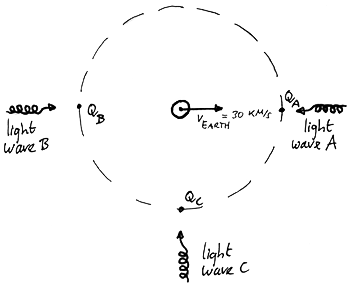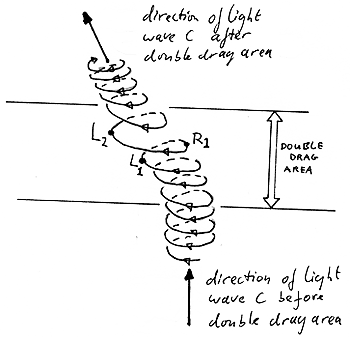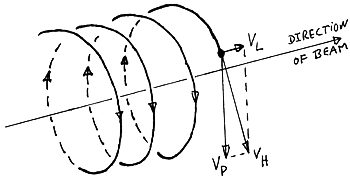|
Figure 3-1-I
Isometric view of a helical particle wave as proposed by Gaasenbeek. The helical velocity (VH) can reach a multiple of c (= 300,000 km/s) as its linear velocity component (VL) approaches c. (VP = peripheral speed) [May 2003: The idea of particle waves has been worked out too by Dr. Vladimir B. Ginzburg19. End May 2003]
When an electron is in a magnetic field its motion is helical, the magnetic force is the centripetal force8. Perhaps, in a way, gravity acts as a force upon a photon like the magnetic force upon an electron, thus bringing the photon into a helical path. A photon may consist of a nucleus (with speed VL) with something orbiting the nucleus (with speed VP), both with their particular spin. A photon may also be a binary system with equal masses or a mono (helical path travelling) system.
[May 2003: Perhaps one should rather not think of a helical path, i.e. a “rotating disk” (of one or more particles) with its plane perpendicular to the forward direction of the light wave (VL), but of a “rotating disk” (of one or more particles) with its plane parallel to the forward direction of the light wave, or: a “rotating disk” which can be in all possible planes through the line of propagation, in order to explain the polarization of light, i.e. the plane of the “rotating disk” then can be polarized. Perhaps another more enveloping way to look at a photon may be: A photon may consist of a nucleus with a second particle orbiting in multiple planes or a photon may consist of two particles orbiting each other in multiple planes or a photon may consist of a particle orbiting an imaginary nucleus (i.e. no nucleus), with all possible 3 systems having two possible ways of orbiting: in every possible plane through the central point of the system (i.e. photon) or in every possible plane through the direction of propagation of system (i.e. photon). Those planes may explain polarization. (Of course there may not be two but 3,4,5... particles in a photon.) End May 2003] [November 2003: One may look at a photon as something that is a particle that moves through space (with a helical path) like blood through our blood vessels, i.e. a photon may be a mass-entity (like an atom or a meteorite or a blood cell). But, of course, a photon eventually may turn out to be something else, for instance: perhaps it is an energy wave (with a helical path) that moves through a medium like sound does through air, a photon then is an extremely concentrated “ball of energy” that goes through a certain medium (the ether) in a way similar to the way our nerve system works or rather: like a concentrated “ball of sound” would move through the air. End November 2003] A gravity particles ocean combined with a photon-particle following a “wave path” may explain the interference pattern of the two-split experiment by Tonomura and co-workers20 with single electrons: the emitted electron goes through the gravity particle ocean, but at the same time certain waves in the gravity particle ocean caused by the electron (or by the electron source) go through the gravity particles field in all (or, at least, many) directions.
[May 2003: Exactly the same has been suggested by Edwards as well as by Buonomano, both in Pushing Gravity5. End May 2003] Thus interference may arise, even when one electron, photon or atom by the time is send through one of the splits: because waves in the gravity (or ether) particle ocean go through the other split and later interfere with the electron, photon or atom. Thus it may be like the nonlocal interpretation by David Bohm20, but then local.
Also the results of the interference experiment for single photons of Aspect and co-workers20 with light from a single-photon source entering a Mach-Zehnder interferometer can be understood by gravity particle waves: the single photon takes one path while gravity particle waves take both paths and interfere later with the photon. The delayed-choice experiment by Walther and co-workers20 can be understood by gravity particle waves too. Also the Pfleegor-Mandel experiment20 with two lasers and only one photon at a time can be explained by gravity particle waves: though one laser emits the photon the other laser causes waves in the gravity particle ocean. Microwaves
The two-split experiment has been performed by Rempe et al with (single) “screened” atoms22.
The atoms were screened in a certain way by microwaves in order to see which split the atoms took. By doing so the interference pattern vanished. The microwaves did not disturb the atoms but they may have disturbed the waves in the gravity particle ocean and perhaps that is the reason why there was no interference found when microwaves showed which path the electrons took. Perhaps this experiment by Rempe and co-workers can be performed as well with only one split being micro waved. This may show half the interference pattern because the atoms that pass the split that is micro-waved then may interfere with gravity particle waves from the other split that is not micro-waved (and so you know which path half of the electrons took because you know which path was micro waved). The aforementioned experiments by Aspect and co-workers, Walther and co-workers and the Pfleegor-Mandel experiment may show a “collapse of the (gravity-particle-)wave function” as well by microwaves. [May 2003: Quantum mechanics is, empirically, the most successful theory of physics so far. The reason for success may be the speed of gravity (or, as mentioned in the beginning of this chapter, the speed of even smaller (ether) particles). The speed of gravity/ether particles may be so much faster than the speed of light (see also Tom Van Flandern in Pushing Gravity5) that it is very difficult to measure that speed.
Uncertainty principle
The Heisenberg uncertainty principle may be a state of the art of nowadays technology. In the future we may find particles to work with that are much smaller than photons and then everything changes and new theories can abolish certain aspects of quantum mechanics.
[May 2003: Actually, the Heisenberg uncertainty principle may continue, but on another level: then smaller particles determine the boundary of what can be measured (but one may never know if there are smaller particles to be found, replacing the boundaries once again). End May 2003] Time dilation
Atom clocks travelling at high velocity around the Earth run slower than atom clocks that stay on Earth. This may not mean that time is physically real as Einstein's theory of relativity states, it may mean that subatomic particles move slower because they have to go through more gravity/ether particles (because of the high velocity of the atom clock relative to the gravity/ether field the clock is in). (This would explain “transverse Doppler shift”12 too.)
[May 2003: The term “gravity/ether field” may be confusing. Perhaps it is best explained by: the Earth has a gravity field because the concentrations of gravity particles in the Universe are influenced by the concentrations of baryonic matter (like our Earth is a concentration of baryonic matter). At the same time the concentrations of a smaller class of particles or smaller classes of particles (smaller than gravity particles) may be concentrated too according to baryonic- matter/gravity-particle concentrations. A gravity/ether field (of a baryonic matter concentration) may relate too: A. (only) gravity particles, B. gravity particles and smaller particles and C. smaller particles.
Different concentrations of gravity/ether particles may mean that (small) differences may be found with the Michelson-Morley experiment of 188110 if the experiment is performed with one (of the two) photon-path(s) having relative more gravity particles. For example: one photon going up and down in a mine (or up and down perpendicular to the surface of the Earth) and the other photon going to and fro over the surface of the Earth. Radioactive particles decay later when they move at high speeds in an accelerator. When the particles move at high speed then their subatomic particles may move less fast (like the subatomic particles in atom clocks) because they move through more gravity particles when at higher speed. Thus like atom clocks may run slower at high speed the radioactive particles may “live” longer and so decay later and hence so-called time dilation may be explained. Perhaps atom clocks can be made running slower and radioactive particles can be made falling apart later by putting them in a strong magnetic field (in the case a magnetic field is caused by gravity/ether particles somehow) or perhaps atom clocks and radioactive particles show differences when they are brought deep into a mine. [May 2003: I know now that many people have found the same reasoning concerning the explanation of “time dilation”, i.e. atom clocks speeding up or slowing down plus radioactive particles delay speeding up or slowing down. Especially Ron Hatch4 and Dr. Paul Marmet11 worked it out thoroughly, but also various authors in Pushing Gravity5 and Assis2 and Ghosh3.
The testing of Bell's inequality by Aspect and co-workers20 showed that: either you give up on locality or you abandon the postulate that nothing goes faster than light.
If there are particles smaller than photons, like gravity/ether particles, then perhaps those smaller particles may be able to travel at (extremely) higher velocities than photons. We have the choice between (A) nothing or (B) (at least) something can go faster than light. Perhaps the results of the experiments of Aspect and co-workers that show “action (or rather: passion) at distance” show necessity for particles or waves going faster than light. [May 2003: Buonomano in Pushing Gravity5 has the same reasoning. End May 2003] [January 2004: If you think about gravity particles/gravitons then isn't it likely that such entities are much smaller entities than photons as well as they are much faster then photons? We checked out sound pretty fast because we can hear sound with our ears and we checked out light (photons) pretty fast because we can see photons with our eyes. Something like gravity we can feel in a way, but it is (more) indirect, we don't have a sense-organ that can “measure” it in a direct way (we need logic within our brains to “see” that there is something like gravity) and this may have made us blind in a way. Gravity particles thus may be much harder for instruments (our ears and eyes are also instruments) to detect because they are extremely small and extremely fast. So far we could not measure gravity particles or ether particles, but as soon as we look through a different lens we find many confirmations of such entities (2-2). End January 2004] Also gravitational blueshift may be the result of something going faster than light. When a light wave falls on Earth it blueshifts. Gravity causing blueshift may be explained by gravity particles going faster than light and therefore pushing the light to a shorter wavelength. Thus gravitational redshift also may be explained with gravity particles/ether. Also the bending of starlight by the Sun may be due to“pushing” of gravity/ether particles.
[July 2004: When gravity acts as a force upon a photon like the magnetic force upon an electron (3-1) then this may explain gravitational redshift too. When an electron (or charged particle) has some speed along a magnetic field line it will follow a helical trajectory. When the electron moves into a region of higher magnetic field strength the circular orbit shrinks while the circular speed increases. Perhaps the same can happen with a photon following a helical trajectory (3-1) within a gravity field. When the photon enters a stronger gravity field the circular orbit may shrink while the circular speed increases, causing the photon to have a higher frequency, i.e. (gravitational) blueshift. When the photon leaves a stronger gravity field its circular orbit may expand while the circular speed decreases, causing the photon to have a lower frequency, i.e. (gravitational) redshift. End July 2004] [May 2003: Gravitational redshift and bending of light have been explained by inertial forces related to gravity/ether by many scientists, see for instance Assis2, Ghosh3 and Hatch4. End May 2003] Perhaps the speed of gravity can be measured with a certain “action (or passion) at distance”, i.e. testing of Bell's inequality, experiments as performed by Aspect and co-workers20.
[May 2003: Caroline Thompson and other scientists favouring local realist models think that something may have gone wrong in Alain Aspect's Bell test experiments. They think that quantum entanglement of separated particles may not happen21. End May 2003] Also: perhaps the speed of gravity can be deduced from measuring changes in gravity force versus changes in light flux. For example: when our Moon eclipses our Sun we may measure different time patterns with respect to: A. change in gravity force (of the Moon + Sun) B. change in light flux (of the Sun); both due to the Moon moving in front of the Sun (I got this idea from Douwe Kiestra, who thought this up and told me I could use it here).
Perhaps in this respect more accurate measurements may be possible with other celestial objects further away than the Moon; for example: our Sun eclipsed by Mercury or Venus, or: eclipsing double stars or a star with a dark (eclipsing) companion. Perhaps spacecraft in space far away from strong gravitational forces can do experiments like this. [May 2003: Kopeikin and Fomalont23 claim to have found the speed of gravity by doing such an experiment. They found that the speed of gravity is consistent with the speed of light by making extreme precise observations when the planet Jupiter passed in front of a bright quasar. This was the first time such an experiment was done and the first time scientists claimed to have measured the speed of gravity.
When a charged particle like an electron, with a helical trajectory, moves into a region of higher magnetic field strength, the circular orbit shrinks while the circular speed increases8. Because the particle's total kinetic energy cannot change, its motion along the field line must slow down8.
If a photon cannot change its speed relative to the gravity field it is in, it has to speed up or slow down when entering another gravity field (that has a different speed, like the gravity field of the Earth relative to the gravity field of the Sun, see 2-1). Because the photon's total kinetic energy cannot change it has to change it's frequency, corresponding with the slowing down or speeding up of the photon. Thus it may change it's circular speed (when the photon follows a helical trajectory), thus redshifting or blueshifting in QB and QA in Fig. 3-1-IIa. Light wave A gets “shortened” in QA: the kinetic energy of the light wave stays the same, but VL decelerates with 30 km/s. If the amplitude stays the same VP may be raised in order to keep the same kinetic energy and hence the frequency may be raised.
 Figure 3-1-IIa
Possible explanation of Doppler effect. The area within the dotted circle represents the gravity field of the Earth. The gravity field of the Sun is outside the dotted circle.  Figure 3-1-IIb
Possible explanation of aberration effect (the figure is leaning a little, sorry). In the case of light wave C we may have: VL stays the same, the amplitude alters and VP-overall stays the same and so the frequency stays the same.
Light wave C may change its direction (see Fig. 3-1-IIb). If there is a double drag area then the light wave may accelerate from L1 to R1 (like VL of light wave B in QB). When it goes from R1 to L2 VP may decelerate (like VL of light wave A in QA). When the (overall) frequency stays the same then: kinetic energy from L1 to R1 = kinetic energy from R1 to L2. And so: if the circular speed between L1 and R1 is higher then its circular orbit shrinks and if the circular speed between R1 and L2 decreases its circular orbit enlarges and thus the light wave deviates to the left (in Fig. 3-1-IIb), which may be the aberration effect. Thus the crash in effect and double drag effect mentioned in 2-2 may be the same. When a photon consists of two particles orbiting each other than those particles may be built up by multiple particles too which may orbit each other. Thus one would get a helical trajectory within a helical trajectory, i.e. the particle(s) going from R1 to L2 follows a helical trajectory too (with much smaller amplitude), which would then possibly explain the deceleration. Thus both Doppler shift and stellar aberration may be explained by the same (intrinsic) principle. [May 2003: I admit that this stellar aberration explaining stuff is quite speculative and beyond the contents of this chapter. And: the reasoning may become difficult with photons having a “rotation disk” that can be in all possible planes that go through the line of propagation, as mentioned above.
|
